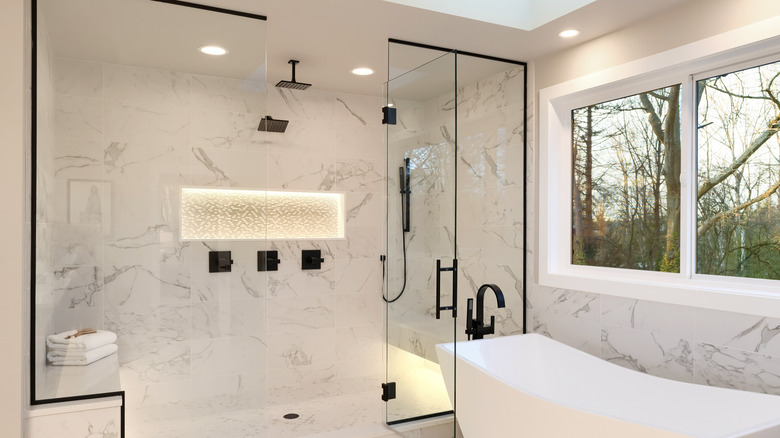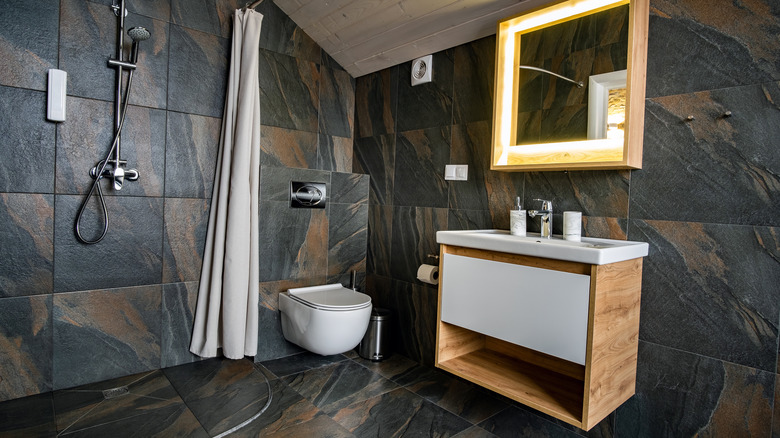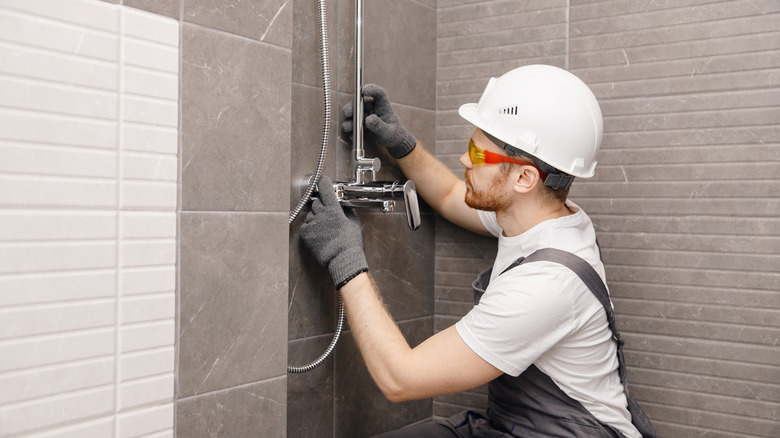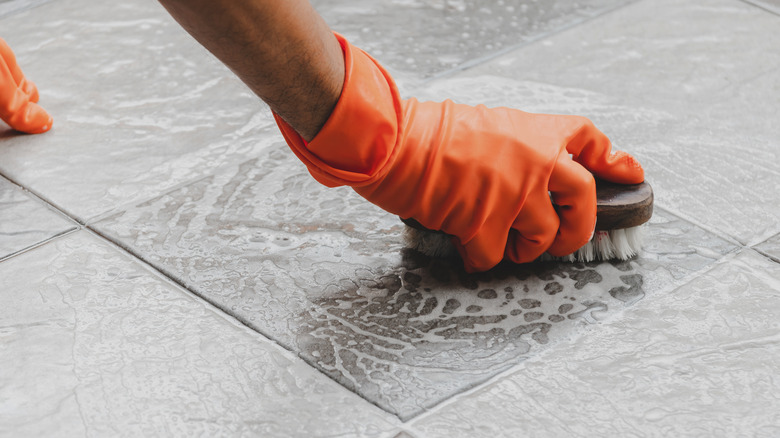What Is A Walk-In Shower And How Are They Different
Keeping clean is a fundamental part of life, making the presence of a shower an important element in every home. Whether it's washing off after going to the pool or relaxing under the warm water after a long day at work, showers keep us clean and relaxed regardless of the day's events. Depending on the style of home and type of bathroom, showers can also come in a variety of styles. A running trend between new and remodeled homes is their shift to walk-in showers.
Because smaller homes, like apartments, have a limited amount of bathroom space, they tend to combine the shower and bathtub into one functioning element. Walk-in showers, however, are showers that are separate from the bathtub. In this case, the bathtub can be either separate or completely absent from the bathroom. Walk-in showers also lack barriers that you must move before stepping in, like a curtain or door, according to House Beautiful. Walk-in showers tend to be closed off by half-walls or glass that is completely or partially open, which means you literally just need to walk in to access the shower. According to The Spruce, some walk-in showers have a door, shower curtain, or barrier that separates the shower from the rest of the bathroom, but real walk-in showers are free of barriers.
Features of a walk-in shower
Home Depot mentions that although walk-in showers can be built much larger, on average, they tend to be between 48 and 60 inches wide and approximately 32 inches deep. They also tend to be built as rectangular, angled, or circular in shape. These dimensions and shapes are all dependent on the size of the bathroom and the style of walk-in shower you want.
When installing a walk-in shower, you can also choose to add your own unique elements to it, allowing the shower to fit your level of comfort and accessibility. Traditionally, walk-in showers do not have barriers that separate them from the rest of the bathroom but to contain the water and the mess it could potentially cause, you can choose to add a barrier, like a door or a shower curtain. Adding a barrier could also create more privacy for the shower user. Choosing the right kind of showerhead according to your shower style is also important. Showerheads change the pressure of the water, which can prevent stray droplets from leaving the shower area, keeping down bathroom messes. Finally, adding a bench to your walk-in shower can increase comfort while also making the space more accessible to a broader range of people.
When you need them
Especially when looking at your home from a long-term point of view, a walk-in shower provides the easy accessibility you may need throughout all the stages of your life and that of any future homeowner. For example, if you or one of your guests is injured or restricted in any way, they will have no troubles getting in and using a walk-in shower because there are no boundaries one needs to overcome for use. They can comfortably use the shower with little to no help in a safe manner, according to Bathroom New Jersey.
Along with the importance of accessibility, walk-in showers are also easily customizable. You can simply add a bench or railing if a user is at a higher risk of falling. Regardless of whether your home is staying trendy and modern, you may want a walk-in shower to either prepare for the different stages and events in your life or to appeal to a wider variety of homeowners you are considering selling your home to.
Pros and cons
Because walk-in showers are a significant household trend, you may be tempted to jump right into the project without seeing the full picture. For starters, a walk-in shower has the potential to completely turn around your bathroom, bringing an elegant and modern look to your home. Depending on the style of walk-in shower you choose, you can also make a small bathroom feel roomier. If you are considering selling your home in the future, a walk-in shower is a great way to appeal to a broader range of people because there is no risk due to stepping over a barrier, and it is easily accessible for wheelchair users, according to Re-Bath.
Although this all may sound great, there are also some downsides to a walk-in shower. Because most walk-in showers have a small or no barrier at all separating it from the rest of the bathroom, escaped water tends to make a bigger bathroom mess as opposed to regular showers. Humidity also tends to expand to other bathroom areas, while drafts quickly make you cold once the water is turned off. Privacy is also at stake with this type of shower because they do not have complete enclosures in which you are separated from the rest of the bathroom. This, however, can be adjusted when installing your own walk-in shower. Along with these slight downsides, the cost of creating a walk-in shower tends to get rather pricey, as well (per Bathroom Pros).
Instillation cost
Comparing the task of installing a walk-in shower to other bathroom projects, Home Guide shows the installation of a walk-in shower as the most expensive to attempt. The cost of a prefab walk-in shower stall ranges from $1,000 to $8,000. For a custom tile walk-in shower, the price ranges from $3,500 to $15,000. If you're looking to convert a bathtub to a walk-in shower, the price ranges from $2,000 to $12,000. Keep in mind these prices are dependent on the quality, materials, and effort of labor that go into each of these projects.
To understand exactly what these prices encompass, JDS Bath shares precisely what goes into the installation of a walk-in shower. First and foremost, unless the project is being done by an outside source, labor is the first cost taken into account. After that, your choice of tiles, accessibility accessories, and individual parts, like the facet, are added to the price of labor. Finally, the cost of plumbing is considered, leading to the total project costs that are mentioned above.
How to care for a walk-in shower
After freshly installing a new walk-in shower, it is more often than not a priority to keep the space looking and smelling its very best for the longest time possible. First and foremost, because a walk-in shower traditionally has no barriers, humidity and water are bound to escape to other parts of the bathroom. To keep humidity down, simply turn on your bathroom exhaust fan while the shower is in use. This technique also keeps your shower from developing mold due to the moisture. Using a daily shower spray also prevents mold and breaks down soap and other types of residues.
Although walk-in showers are known for being easier to clean compared to other types of showers, it is still important to keep up routine maintenance for it to always look its best. Grout lines should be sealed approximately every six months to keep hard water stains and mildew from growing. Tile walls should be scrubbed clean with a bristle brush every week if the shower is used on a routine basis. Glass panels should be squeegeed and wiped down with glass cleaner nearly every day, as well, according to Bob Vila.





